Quantifying CO2 Emissions and Energy Production from Power Plants to Run HVAC Systems in ASHRAE-Based Buildings
Abstract
1. Introduction
2. Methodology
2.1. The Validity Simulation Software
2.2. Numerical Model Specifications and Assumptions
3. Results and Discussion
3.1. Overall Annual Performance
3.2. Monthly Performance
3.3. Techno-Economic
4. Conclusions
Author Contributions
Funding
Data Availability Statement
Conflicts of Interest
References
- Yang, L.; Yan, H.; Lam, J.C. Thermal comfort and building energy consumption implications—A review. Appl. Energy 2014, 115, 164–173. [Google Scholar] [CrossRef]
- International Energy Agency. Transition to Sustainable Buildings: Strategies and Opportunities to 2050. 2013. Available online: https://www.iea.org/reports/transition-to-sustainable-buildings (accessed on 5 October 2021).
- International Energy Agency. Cooling. 2014. Available online: https://www.iea.org/reports/cooling (accessed on 3 July 2021).
- International Energy Agency. The Future of Cooling: Opportunities for Energy-Efficient Air Conditioning. 2014. Available online: https://www.iea.org/reports/the-future-of-cooling (accessed on 14 September 2021).
- Conti, J.; Holtberg, P.; Diefenderfer, J.; LaRose, A.; Turnure, J.T.; Westfall, L. International Energy Outlook 2016 with Projections to 2040. 2016. Available online: https://www.osti.gov/servlets/purl/1296780 (accessed on 26 June 2022).
- Beck, H.E.; Zimmermann, N.E.; McVicar, T.R.; Vergopolan, N.; Berg, A.; Wood, E.F. Present and future Köppen-Geiger climate classification maps at 1-km resolution. Sci. Data 2018, 5, 180214. [Google Scholar] [CrossRef] [PubMed]
- Nematollahi, O.; Hoghooghi, H.; Rasti, M.; Sedaghat, A. Energy demands and renewable energy resources in the Middle East. Renew. Sustain. Energy Rev. 2016, 54, 1172–1181. [Google Scholar] [CrossRef]
- King Abdullah Petroleum Studies and Research Center KAPSARC. The Future of Cooling in Saudi Arabia: Technology, Market and Policy Options. 2020, pp. 1–23. Available online: https://www.kapsarc.org/research/publications/the-future-of-cooling-in-saudi-arabia-technology-market-and-policy-options/ (accessed on 1 July 2022).
- Sachar, S.; Campbell, I.; Kalanki, A. Solving the Global Cooling Challenge: How to Counter the Climate Threat from Room Air Conditioners. 2018. Available online: https://rmi.org/wp-content/uploads/2018/11/Global_Cooling_Challenge_Report_2018.pdf (accessed on 24 June 2022).
- US Green Building Council UGBC. Leadership in Energy and Environmental Design. LEED. 2019. Available online: https://www.usgbc.org/leed (accessed on 2 October 2021).
- Building Research Establishment (BRE). Building Research Establishment Environmental Assessment Method. BREEAM. 2019. Available online: https://bregroup.com/products/breeam/breeam-solutions/ (accessed on 30 November 2021).
- American Society of Heating, Refrigerating, and Air-Conditioning Engineers (ASHRAE). Standard 55—Thermal Environmental Conditions for Human Occupancy. 2017. Available online: https://www.ashrae.org/technical-resources/bookstore/standard-55-thermal-environmental-conditions-for-human-occupancy (accessed on 25 January 2022).
- ISO 7730:2005; Ergonomics of the Thermal Environment—Analytical Determination and Interpretation of Thermal Comfort Using Calculation of the PMV and PPD Indices and Local Thermal Comfort Criteria. ISO: Geneva, Switzerland, 2005; Management Volume 3. pp. 605–615.
- Fanger, P.O.; Toftum, J. Extension of the PMV model to non-air-conditioned buildings in warm climates. Energy Build. 2002, 34, 533–536. [Google Scholar] [CrossRef]
- Elnaklah, R.; Alnuaimi, A.; Alotaibi, B.S.; Topriska, E.; Walker, I.; Natarajan, S. Thermal comfort standards in the Middle East: Current and future challenges. Build. Environ. 2021, 200, 107899. [Google Scholar] [CrossRef]
- Humphreys, M.A.; Nicol, J.F. The validity of ISO-PMV for predicting comfort votes in every-day thermal environments. Energy Build. 2002, 34, 667–684. [Google Scholar] [CrossRef]
- Kenawy, I.; Elkadi, H. The impact of cultural and climatic background on thermal sensation votes. In Proceedings of the 29th Sustainable Architecture for a Renewable Future Conference PLEA 2013, Munich, Germany, 10–12 September 2013. [Google Scholar]
- Aljawabra, F.; Nikolopoulou, M. Influence of hot arid climate on the use of outdoor urban spaces and thermal comfort: Do cultural and social backgrounds matter? Intell. Build. Int. 2010, 2, 198–217. [Google Scholar] [CrossRef]
- De Dear, R.; Brager, G.S. The adaptive model of thermal comfort and energy conservation in the built environment. Int. J. Biometeorol. 2001, 45, 100–108. [Google Scholar] [CrossRef] [PubMed]
- Alrebei, O.F.; Obeidat, B.; Abdallah, I.A.; Darwish, E.F.; Amhamed, A. Airflow dynamics in an emergency department: A CFD simulation study to analyse COVID-19 dispersion. Alex. Eng. J. 2021, 61, 3435–3445. [Google Scholar] [CrossRef]
- Obeidat, B.; Alrebei, O.F.; Abdallah, I.A.; Darwish, E.F.; Amhamed, A. CFD Analyses: The Effect of Pressure Suction and Airflow Velocity on Coronavirus Dispersal. Appl. Sci. 2021, 11, 7450. [Google Scholar] [CrossRef]
- Al-Hafith, O.; Satish, B.K.; Bradbury, S.; de Wilde, P. Simulation of courtyard spaces in a desert climate. Energy Procedia 2017, 142, 1997–2002. [Google Scholar] [CrossRef]
- DS Limited. DesignBuilder 2.1. User’s Manual. 2009. Available online: http://www.designbuildersoftware.com/docs/designbuilder/DesignBuilder_2.1_Users-Manual_Ltr.pdf (accessed on 2 October 2021).
- DS Limited. ASHRAE 140-2017/BESTEST Results for DesignBuilder v6.1. 2021. Available online: https://designbuilder.co.uk/download/documents (accessed on 28 March 2022).
- Judkoff, R.; Neymark, J. International Energy Agency Building Energy Simulation Test (BESTEST) and Diagnostic Method; National Renewable Energy Lab. (NREL): Golden, CO, USA, 1995. [CrossRef]
- Mustafaraj, G.; Marini, D.; Costa, A.; Keane, M. Model calibration for building energy efficiency simulation. Appl. Energy 2014, 130, 72–85. [Google Scholar] [CrossRef]
- Alrebei, O.F.; Obeidat, L.M.; Ma’Bdeh, S.N.; Kaouri, K.; Al-Radaideh, T.; Amhamed, A.I. Window-Windcatcher for Enhanced Thermal Comfort, Natural Ventilation and Reduced COVID-19 Transmission. Buildings 2022, 12, 791. [Google Scholar] [CrossRef]
- Mabdeh, S.; Al Radaideh, T.; Hiyari, M. Enhancing Thermal Comfort of Residential Buildings Through a Dual Functional Passive System (SOLAR-WALL). J. Green Build. 2021, 16, 155–177. [Google Scholar] [CrossRef]
- Crawley, D.; Lawrie, L. Repository of Free Climate Data for Building Performance Simulation. 2018. Available online: https://climate.onebuilding.org/WMO_Region_2_Asia/QAT_Qatar/index.html (accessed on 10 March 2022).
- Saffouri, F.; Bayram, I.S.; Koc, M. Quantifying the cost of cooling in Qatar. In Proceedings of the 2017 9th IEEE-GCC Conference and Exhibition, Manama, Bahrain, 8–11 May 2017. [Google Scholar] [CrossRef]
- Indraganti, M.; Boussaa, D. Comfort temperature and occupant adaptive behavior in offices in Qatar during summer. Energy Build. 2017, 150, 23–36. [Google Scholar] [CrossRef]
- GlobalPetrolPrices. Qatar Electricity Prices, December 2021. 2022. Available online: https://www.globalpetrolprices.com/Qatar/electricity_prices/ (accessed on 1 August 2022).
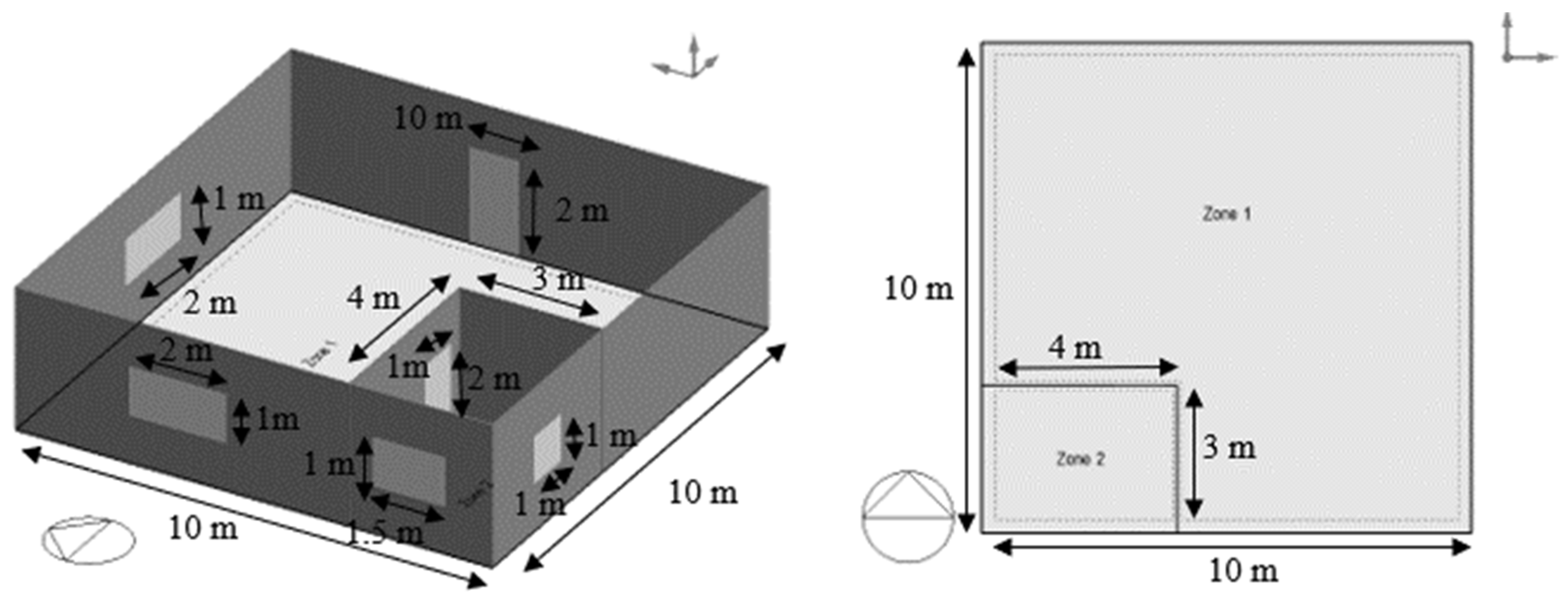
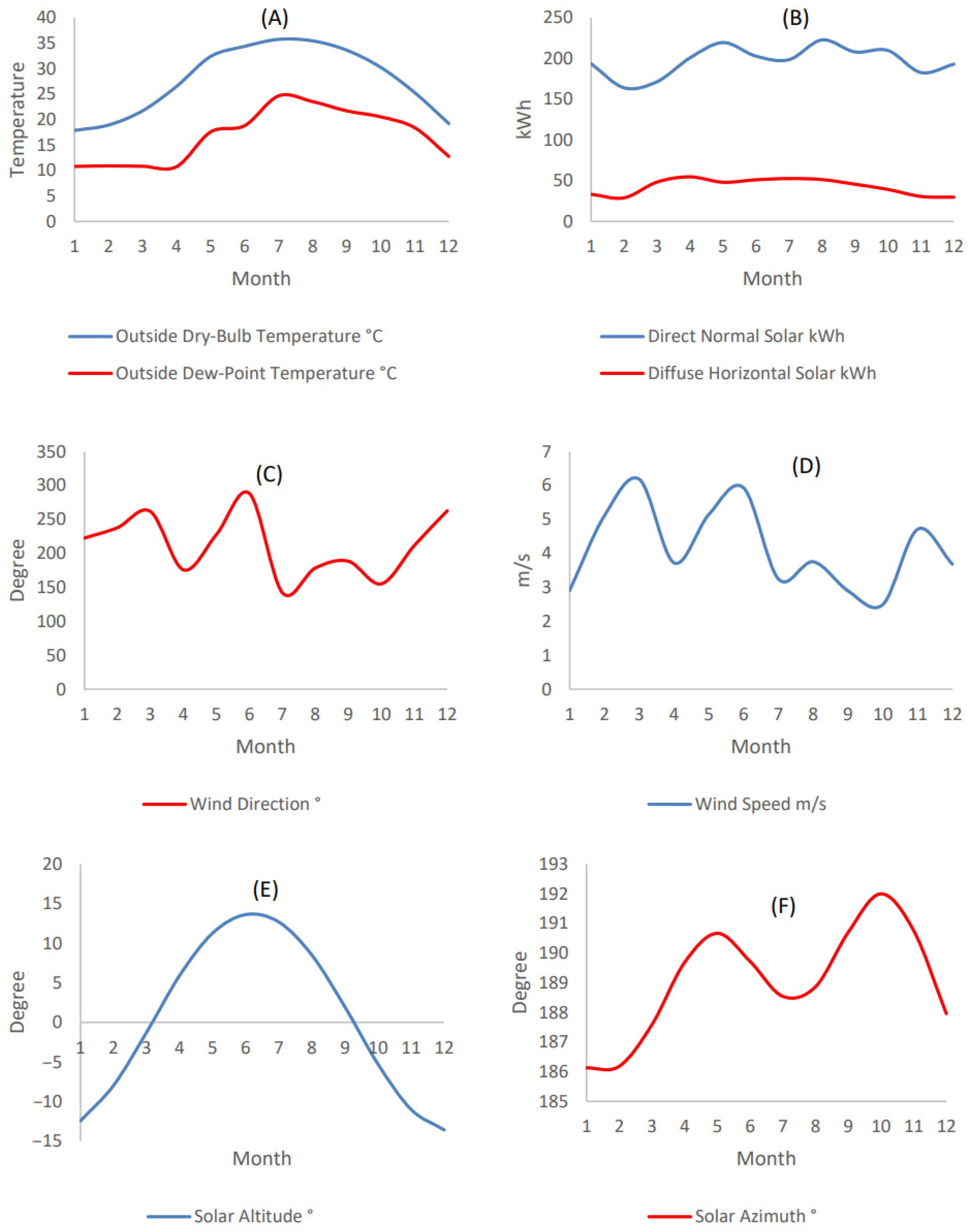

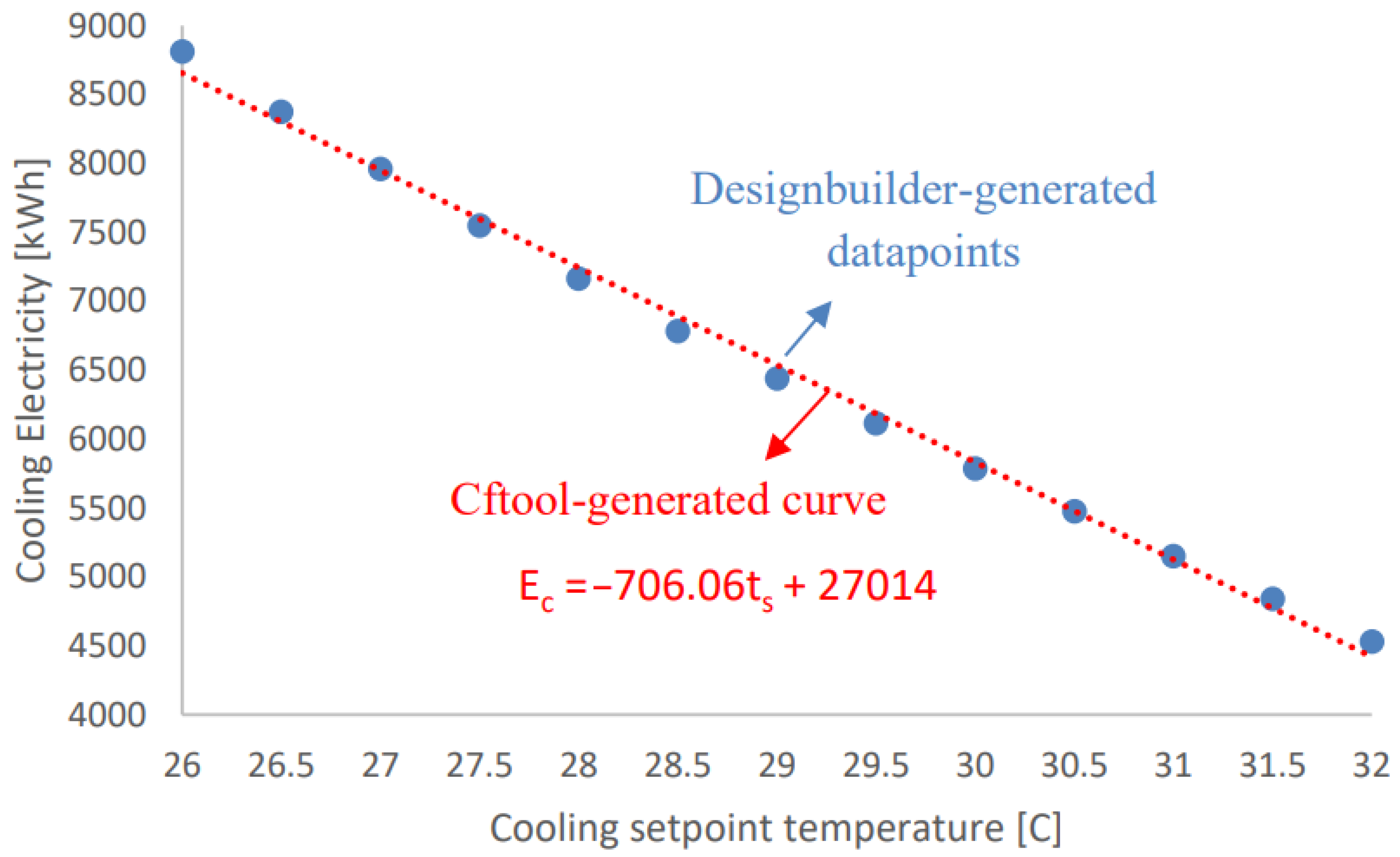




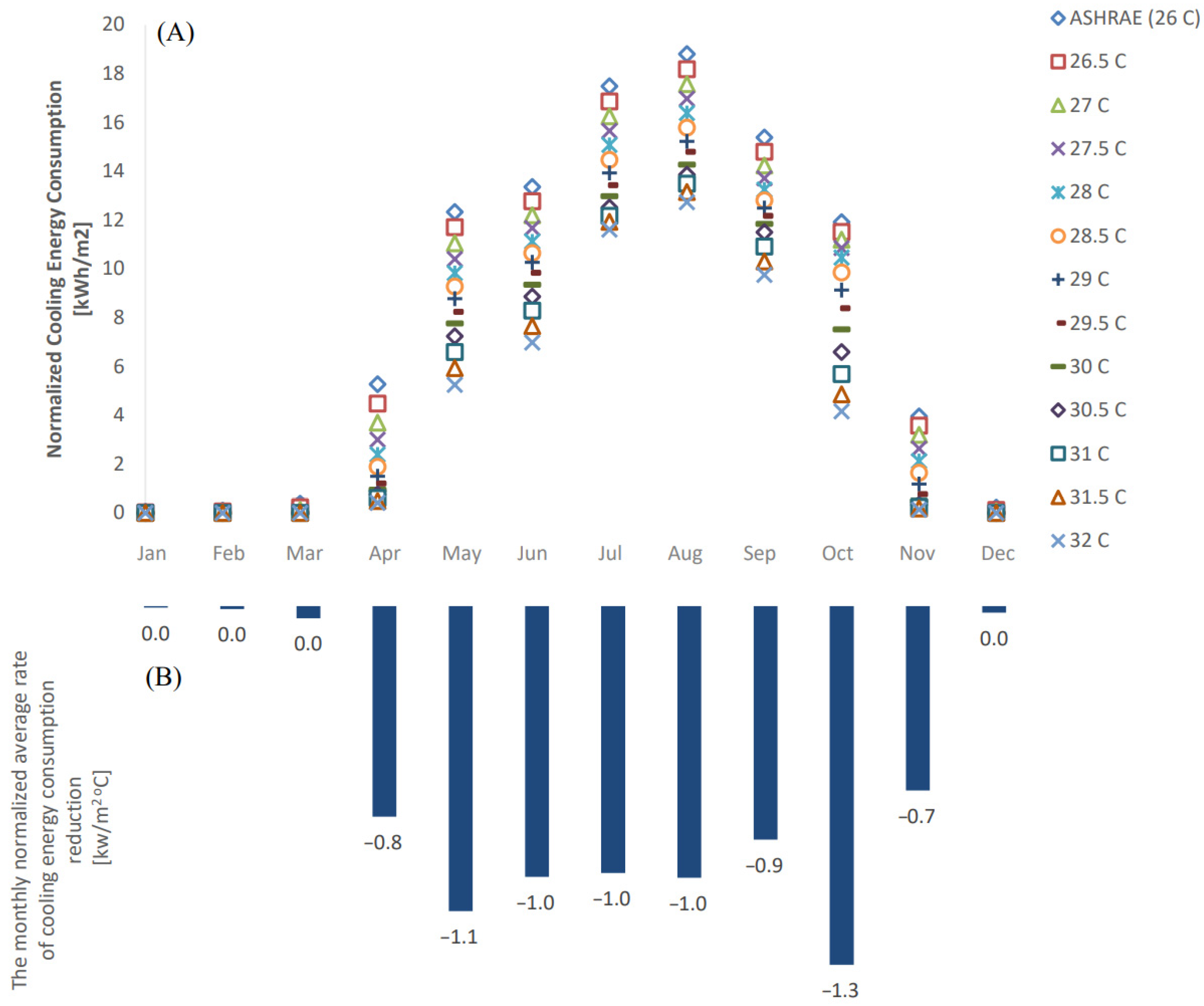
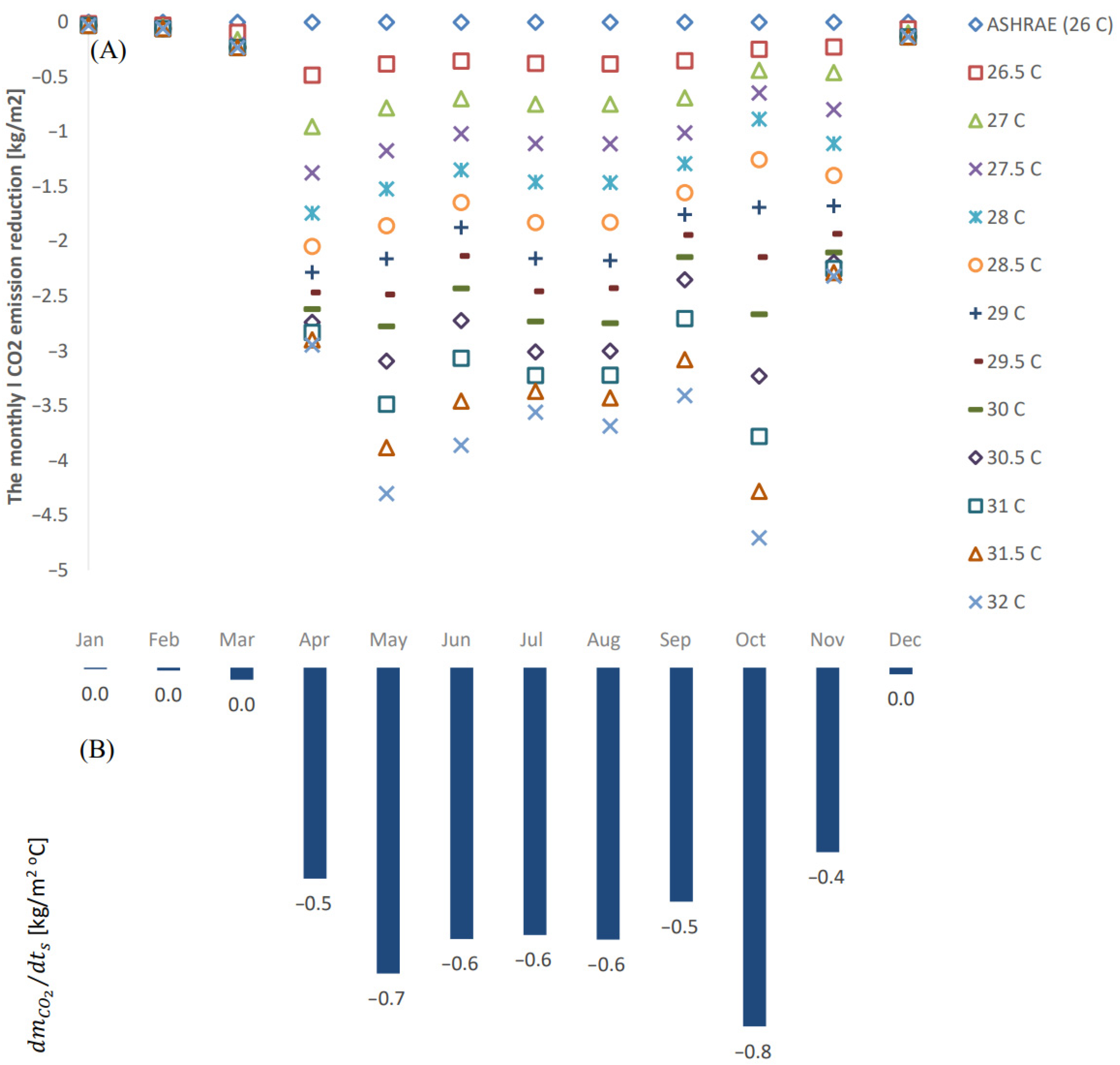
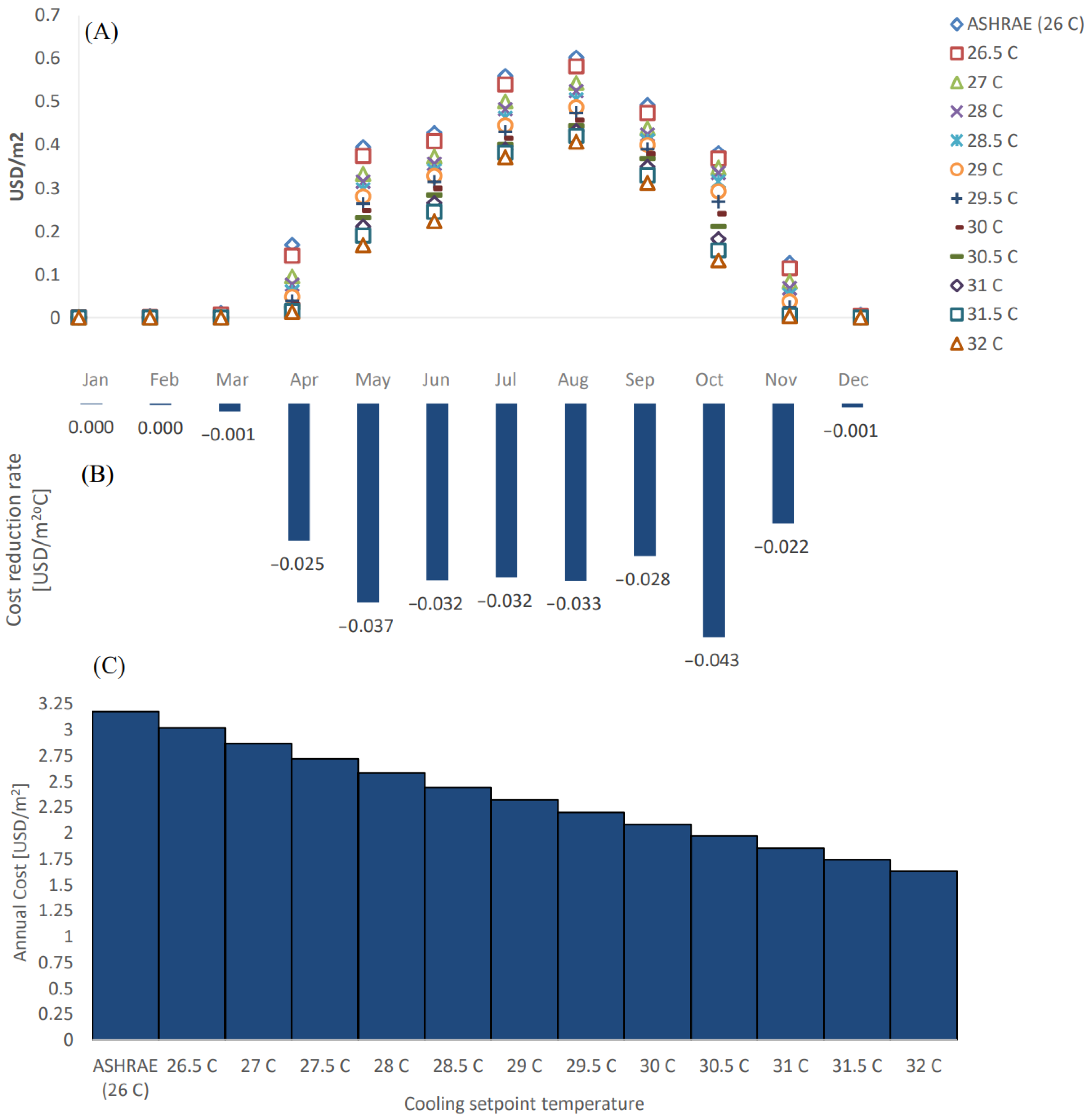
| Parameter Category | Parameter | ASHRAE Control Case [12,23] | Variable Interval |
|---|---|---|---|
| Heating setpoints | Heating setpoint when the building is occupied [°C] | 20 | Constant |
| Heating setpoint when the building is unoccupied [°C] | 13 | Constant | |
| Cooling setpoints | Cooling setpoint when the building is occupied [°C] | 26 | [26–32 °C] with a step size of 0.5 °C |
| Cooling setpoint when the building is unoccupied [°C] | 32 | Constant | |
| Operation Schedule | Heating | Limited by the occupancy schedule (ASHRAE Residential Occ) | Constant |
| Cooling | Limited by the occupancy schedule (ASHRAE Residential Occ) | Constant |
| Parameter | Specification | Reference | |
|---|---|---|---|
| Building dimensions | As shown in Figure 1 | [27,28] | |
| Airtightness | 0.05 ac/h | ||
| Fluorescent | T8 25 mm diam | ||
| Power density | 10.2 W/m2 | ||
| Control | ON/OFF demining daylighting control | ||
| HVAC system | Configuration | Split-no fresh air | [12,23] |
| Heating | Within ASHRAE definition | ||
| Cooling | Within ASHRAE definition | ||
| Natural ventilation | Within ASHRAE definition | ||
| Occupancy | Occupancy density [people/m2 ] | 0.0215 | |
| Schedule | ASHRAE Residential Occ | ||
| Construction | External wall | Layer 1: Cement Plaster: 0.03 m | [27,28] |
| Layer 2: Block: 0.2 m | |||
| Layer 3: Cement plaster 0.03 m | |||
| Internal wall | Layer 1: Cement Plaster: 0.03 m | ||
| Layer 2: Block: 0.1 m | |||
| Layer 3: Cement plaster 0.03 m | |||
| Roof | Layer 1: Cast Reinforced concrete: 0.1 m | ||
| Layer 2: Block + Reinforced concrete: 0.15 m | |||
| Layer 3: Cement plaster 0.03 m | |||
| Floor | Layer 1: Gravel-based Soil: 0.2 m | ||
| Layer 2: Sand: 0.05 m | |||
| Layer 3: Cast reinforced concrete: 0.1 m | |||
| Windows | Sliding, single clear glazing: 0.06 m, 50% glazing open | ||
| Aluminum framing: 0.05 m | |||
| Doors | Area door opens: 100% | ||
| Parameter | Effect |
|---|---|
| Operative temperature | Increased by an additional 0.25 °C |
| The overall cooling energy consumption of the building. | Reduction of 706 kWh |
| The overall CO2 emissions of the building. | Reduction of 426.24 kg |
| The percentage reduction in the overall cooling energy consumption of the building. | Reduction of 8% compared to ASHRAE standard setpoint. |
| The normalized (by occupied area) cooling energy consumption. | Reduction of 8 kWh for each 1 m2 of the occupied area. |
| The normalized (by occupied area) CO2 emissions. | Reduction of 4.8 kg for each 1 m2 of the occupied area. |
| Month | Cooling Energy Reduction Rate [kWh/m2 °C] | CO2 Emission Reduction Rate [kg/m2 °C] |
|---|---|---|
| October | −1.3 | −0.85 |
| May | −1.1 | −0.7 |
| June, July, and August | −1 | −0.6 |
| September | −0.9 | −0.5 |
| April | −0.8 | −0.45 |
| November | −0.7 | −0.4 |
| January, February, March, and December | Negligible | Negligible |
Publisher’s Note: MDPI stays neutral with regard to jurisdictional claims in published maps and institutional affiliations. |
© 2022 by the authors. Licensee MDPI, Basel, Switzerland. This article is an open access article distributed under the terms and conditions of the Creative Commons Attribution (CC BY) license (https://creativecommons.org/licenses/by/4.0/).
Share and Cite
Alrebei, O.F.; Obeidat, B.; Al-Radaideh, T.; Le Page, L.M.; Hewlett, S.; Al Assaf, A.H.; Amhamed, A.I. Quantifying CO2 Emissions and Energy Production from Power Plants to Run HVAC Systems in ASHRAE-Based Buildings. Energies 2022, 15, 8813. https://doi.org/10.3390/en15238813
Alrebei OF, Obeidat B, Al-Radaideh T, Le Page LM, Hewlett S, Al Assaf AH, Amhamed AI. Quantifying CO2 Emissions and Energy Production from Power Plants to Run HVAC Systems in ASHRAE-Based Buildings. Energies. 2022; 15(23):8813. https://doi.org/10.3390/en15238813
Chicago/Turabian StyleAlrebei, Odi Fawwaz, Bushra Obeidat, Tamer Al-Radaideh, Laurent M. Le Page, Sally Hewlett, Anwar H. Al Assaf, and Abdulkarem I. Amhamed. 2022. "Quantifying CO2 Emissions and Energy Production from Power Plants to Run HVAC Systems in ASHRAE-Based Buildings" Energies 15, no. 23: 8813. https://doi.org/10.3390/en15238813
APA StyleAlrebei, O. F., Obeidat, B., Al-Radaideh, T., Le Page, L. M., Hewlett, S., Al Assaf, A. H., & Amhamed, A. I. (2022). Quantifying CO2 Emissions and Energy Production from Power Plants to Run HVAC Systems in ASHRAE-Based Buildings. Energies, 15(23), 8813. https://doi.org/10.3390/en15238813






